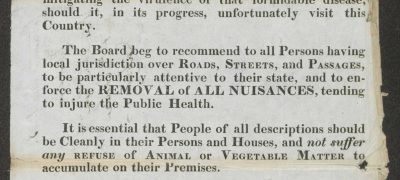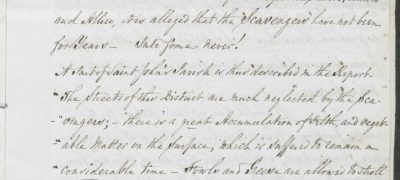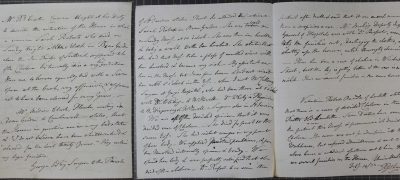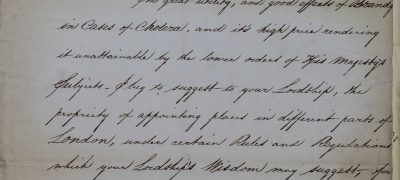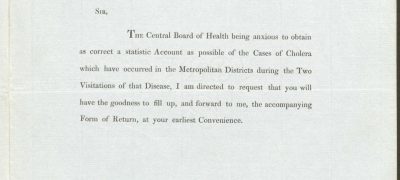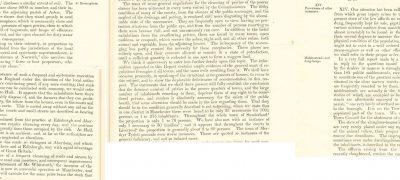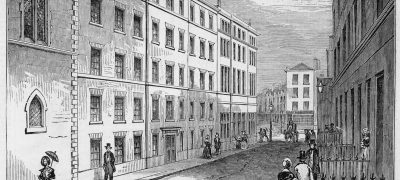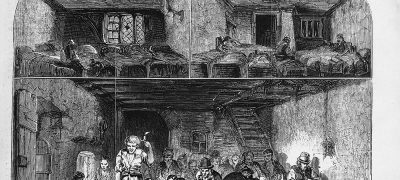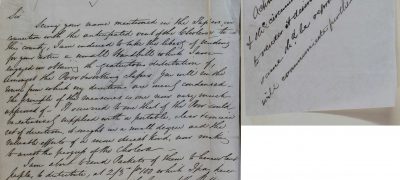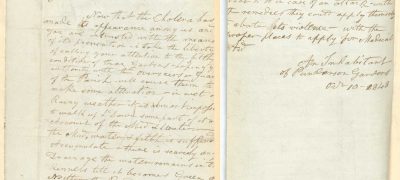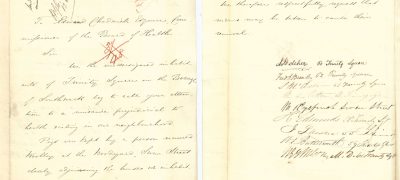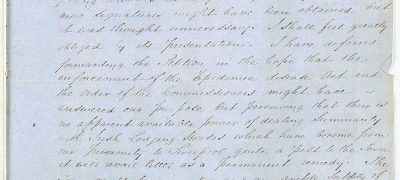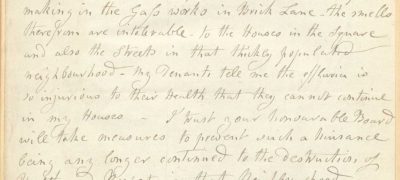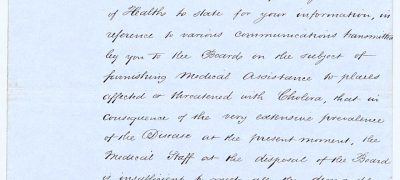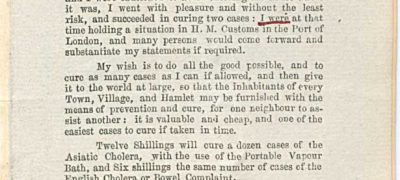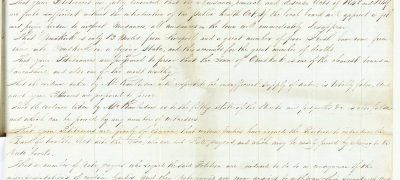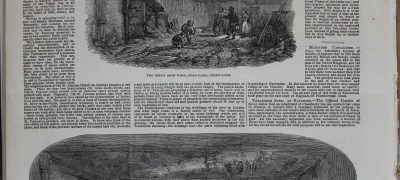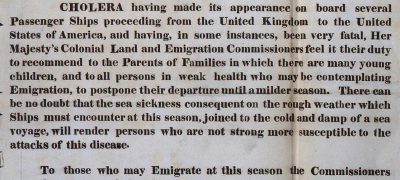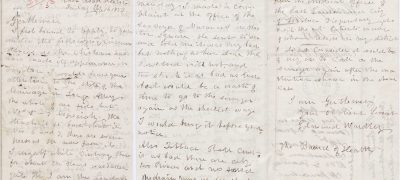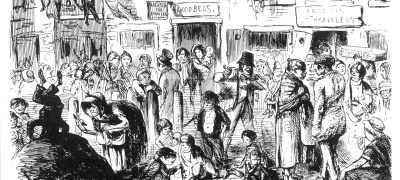Teachers' notes
This collection of documents with transcripts relating to urban living conditions in the 19th century is aimed at any teacher or student engaged in the study of public health problems in industrial Britain; cholera epidemics; the role of public health reformers or local and national government involvement in public health improvement. The collection could be used to help provide a sense of period and show students a range of archival material including cartoon, photographs, reports, census pages, letters and newspaper extracts.
These documents can be used alongside our lesson called Coping with Cholera which also contains more sources on cholera and the government’s response to the disease. It would be helpful for students to consider the following general guidance questions below on how to evaluate and understand documents.
- What type of document is it? (letter, report, photograph or newspaper)
- Can you find a date?
- What is the document saying?
- Check the meaning of any words you are unsure about
- What names appear in the document?
- Does the document show the writer’s opinions/values?
- Are there any clues about the intended audience for the document?
- Why was the document written?
- Does it have any limitations?
- Does it link to other documents in the group?
- Does it share the same ideas, attitudes and arguments?
- How would you explain any differences between these documents?
- Why do you think The National Archives has this document?
Themes in the collection
- Problems of industrial towns: poor drainage, pollution, lack of sewerage system, overcrowding, disease.
- Government response to poor housing
- Government response to cholera: What to the sources reveal about the understanding of the cause of the disease?
- Cholera cures from individuals: What to the sources reveal about the understanding of the cause of the disease?
- What attempts came from private individuals, localities or organisations to improve housing/health or reduce homelessness?
- What do these housing conditions reveal about the power of local authorities, landlords or private individuals to improve conditions in the towns?
- Class differences in housing: How can we find out about these?
- What different types of archival material be used to find out about public health and housing?
Teachers may want to break their class up into groups. Students could work on several documents or a pre-selected group covering a particular theme. Students then feedback on their documents and/or annotate them at a white board. Or teachers may wish to use these documents for an enquiry question of their own.
You may wish to use the collection to develop your own printed or digital resources. Students could be asked to ‘curate’ their own ‘exhibition’ from the collection of the most significant sources on the public health and housing.
Curriculum links:
Key stage 4
AQA GCSE
Improvements in public health: public health problems in industrial Britain; cholera epidemics; the role of public health reformers; local and national government involvement in public health improvement, including the 1848 and 1875 Public Health Act.
Edexcel GCSE
C1700–1900: Medicine in 18th & 19th century Britain: fighting cholera in London, attempts to prevent its spread; the significance of Dr John Snow.
OCR GCSE
The Peoples’ Health: Industrial Britain C1750-1900: Industrial Britain, c.1750–c.1900
Industrialisation, the growth of major cities and political change: an overview.
Urban living conditions in the early nineteenth century: housing, food, clean water and waste. Responses to cholera epidemics. Public health reform in the nineteenth century including the Public Health Acts and local initiatives.
Key stage 5
AQA GCE
The Age of Reform: Britain, 1832–1885,
Political change and social reform. Social developments: conditions in urban Britain, campaigners including Shaftesbury and Chadwick, pressure for change, public health reform.
Edexcel GCE
Poverty, public health and the state in Britain, c1780–1939
The impetus for change, c1780–1939: problems of public health created by industrialisation; impact of epidemics and reports on the state of towns and of increasing understanding about causes of disease.
Changes in the attitudes of public, press and parliament to public health issues and the impact of the work of individuals.
Introduction
The industrial revolution had a massive impact on the growth of towns. In 1700 Manchester was a small village with less than 10,000 inhabitants. By 1801 Greater Manchester had become a city of 328,609 people. Liverpool, Leeds and Huddersfield were similar in size. By 1851 the population of Manchester had increased to 1,037,001 and the north of England contained half the population of the country. London too had grown from of a population of 1,011,157 in 1801 to 2,651,939 in 1851 and by 5,571,968 by 1891.
People came to the towns in search of work. The development of steam power meant that factories did not have to be located near rivers using water for power. Factories offered higher wages than agricultural work. Their workforce was often forced to live in crowded back-to-back housing, built by factory owners near to the factory. Rows of houses were separated from each other by a court, or strip of muddy ground. There were no bathrooms, toilets, running water or heating apart from a single fireplace also used for cooking. People would have to share a water pump and privy in the street which probably served at least twenty houses. The privies often overflowed and the waste often soaked into wells that supplied the water pump, or flooded into the court which was turned into an open sewer running between the houses. These cramped houses were often home to four or five families, possibly with lodgers and another family living in the cellar. The cellars themselves were damp, dark and frequently subject to flooding.
Extracts in this collection from the ‘Second Report of Commissioners of Inquiry into the State of Large Towns and Populous. Districts, 1842’ [HO 45/416] for example, describe conditions in Birmingham, Hull, Manchester, Liverpool Sunderland, Aberdeen and Edinburgh. The extracts also provide some insight into the work of the commission, how it gathered its evidence and made recommendations. Taken with several ‘nuisance letters’ from private individuals to the General Board of Health about a range of different ‘nuisances’- piles of rubbish and waste, poor drains or sewers or livestock in the streets or effects of a nearby gasworks for example, [MH13/261] we get a graphic insight into living conditions in the towns.
Unsurprisingly, the average life expectancy contrasted greatly between town and countryside and also shows a great disparity between social classes. In 1840, 57% of the poor children living in Manchester died before they were 5 years. In rural areas this was 32%. An agricultural worker in Rutland had a life-expectancy of 38, a factory worker in Liverpool, a life expectancy of 15 years. Urban living was not conducive to good health for the poorer classes particularly and cholera thrived in situations where there was an impure water supply. Documents here also explore the response to cholera from quack cures, like the cholera bath [MH 13/245/120] or use of brandy, [HO 44/25] to government advice in 1831 [HO 44/24/57] capturing the palpable fear with which this disease was held.
The layout of an industrial town reflected its class divisions. The poorest lived in the central slums near the factories. Extracts from a report [HO 44/24/87] sent to the Home Office from by the Medical Secretary for Visiting District Committees of the local Board of Health for St Margaret and St John the Evangelist also provide a picture of living conditions in Westminster in 1831 for example. Surrounding the centre of city, skilled trades’ people lived in small terraced houses. Moving further away, the middle classes built their semi-detached villas in Turnham Green like the design shown [COPY 1.39 f348] in this collection. Larger detached homes with running water and large gardens existed in the more rural suburbs, and may have had the look of the ‘country house’ in the cut out source. [COPY 1/ 59 f258]. These homes later became more comfortable as they were supplied with electricity, [ZPER 35/9].
The rapid growth of towns meant there was little attention to urban planning including proper sewage and drainage systems or decent paving. Rubbish and filth accumulated in the streets, there was no systematic rubbish collection or street cleaning. There was no fire service, this was left to private companies. There was no control over air pollution either, so factory smoke and smog were a regular fact of life. London, and the cities in the midlands and north of the country were the unhealthiest places to live. Disease spread rapidly, especially among the urban poor. Cholera, smallpox and typhoid were common causes of death. Public health improved in the city of London with the achievement of Joseph Bazalgette, an engineer who built a sewer network for London in the 1870s. This was crucial in reducing cholera epidemics as it prevented raw sewage being emptied into the Thames.
Many well-off Victorians felt that the slums were caused by the laziness of the poorer classes, however other reformers, writers and campaigners in the second half of the nineteenth century, said that they resulted from poverty, unemployment, or homelessness. [MEPO 2/203]. George Peabody, an American businessman for example, built a number of model homes for the poor, called Peabody Buildings. [ZPER 34/54]
Public health improved in the towns and cities after further government enquiries into over the century. In 1871 a new government department was formed to look after public health. In 1872 the country was split into Sanitary Authorities with a sanitary inspector and a medical officer of health. According to the 1875 Public Health Act all new accommodation was to have running water and proper drainage, and local authorities had to maintain sewers.
In 1875, the Artisans’ and Labourers’ Dwellings Act gave local authorities powers to clear and redevelop slum areas and re-house inhabitants. Birmingham was the first city take advantage of the scheme. Another Act in 1890 expanded these provisions and other towns followed suit.
External links
Find out more about Henry Mayhew’s book ‘London Labour and the London Poor’ containing his investigations into the lives of the London’s working class. https://www.bl.uk/romantics-and-victorians/articles/henry-mayhews-london-labour-and-the-london-poor
Read articles with original sources from the British Library which explore different aspects of urban life in Victorian Britain, including the built environment, class, poverty, crime and popular culture: https://www.bl.uk/victorian-britain/articles
Look into the role of Edwin Chadwick and public health reform using this useful article: https://www.ncbi.nlm.nih.gov/pmc/articles/PMC1113797/
‘Construction of London’s Victorian sewers: the vital role of Joseph Bazalgette’ Postgraduate Medical Journal: 2001, G.C. Cook. https://pmj.bmj.com/content/77/914/802
Charles Booth’s London: Search the original poverty maps and notebooks from his ‘Inquiry into Life and Labour in London’, 1886-1903 from London School of Economics: https://booth.lse.ac.uk/
Back to top
